Giovanni di Pietro, lo Spagna acquired his nickname because he was born in Spain. The circumstances in which he moved to Italy are unknown. He was first documented in the Florentine workshop of Perugino in 1492, at which point he seems to have been a very young assistant. A panel of Christ carrying the cross from the Monastero della Beata Colomba, Perugia (below) seems to have been painted before 1497, but its attribution to lo Spagna is uncertain. He is documented in Spello in 1502, and could have worked as an assistant to Pintoricchio there.
Lo Spagna received the important commission for the altarpiece of the Coronation of the Virgin for the Observant Franciscans of Santa Maria di Montesanto, Todi (below) in 1507, but does not seem to have started work on it until 1511. Before that date, he had almost certainly completed three panels of the Adoration of the Magi that are very similar to each other:
-
✴the altarpiece that Abbot Eusebio Ancaiani of Spoleto commissioned for San Pietro in Valle (below) in 1508;
-
✴the so-called Madonna della Spineta for the church of this name outside Todi; and
-
✴the main panel of an altarpiece for Sant’ Antonio Abate, Perugia (below), which was probably complete by 1510, the year in which another artist was commissioned to paint the predella.
According to Giorgio Vasari, lo Spagna worked with Perugino in Perugia, but left the city after Perugino’s death (i.e. in 1524) because the other painters there were “so hostile to strangers”. Since his source was Dono Doni, who had worked as an assistant to lo Spagna, as a young man, this information is likely to be broadly correct. Fr. Ludovico da Pietralunga, who was close to Dono Doni, repeats this story in his guide (ca. 1575) to San Francesco, Assisi. He points out that lo Spagna worked in many cities in Umbria, except Perugia, and he blames the actions of fellow-artists such as Giannicola di Paolo and Domenico Alfani. (This account mentions that Raffaellino del Colle trained under lo Spagno).
The Commune of Spoleto granted citizenship to “magistri Iohannis hyspani pictoris excellentissimi” in 1516, at which point he had lived in Spoleto for many years and to have married there. In another document of 1516, he is recorded as the son-in-law of Nicolò Martorelli, who settled property on him and his wife, Santina. He was nominated Capitano delle Arti dei Pittori e degli Orefici in 1517. One of his daughters married Jacopo Siculo, another “foreign” artist who had settled in Spoleto.
Lo Spagna died in Spoleto in 1528, possibly of the plague, while at work in San Giacom di Spoleto (below). The last fresco to be commissioned from him in that church was completed after his death by his assistants, Dono Doni (mentioned above) and Cecco di Bernardino d’ Assisi.
Spoleto
Adoration of the Magi (1508)
Abbot Eusebio Ancaiani commissioned this documented altarpiece from lo Spagna for the high altar of San Pietro in Valle in 1508. Abbot Decio Ancaiani moved it to the chapel next to Palazzo Ancaiani, Spoleto in 1733. The family took it to Rome in 1825 and sold it to the art gallery of Berlin in 1833. It is now in the Staatliche Museen, Berlin.
Works from the Rocca di Albornoz (1514-5)
A number of frescoes from the Rocca that are attributed to lo Spagna are now in the Sala Lo Spagna of Palazzo Comunale.
-
✴Madonna and Child with saints
-
This fresco from the Rocca depicts the Madonna and Child with: SS Jerome (with his lion); Nicholas of Tolentino; Catherine of Alexandria; and Brictius. The arms in the lunette are those of Pietro di Nicolò Ridolfi: his wife, Contessina dei Medici, was the sister of Pope Leo X, who appointed Ridolfi as governor of Spoleto in the period 1514-6. The fresco must have been commissioned before 1516, when the Ridolfi arms were modified.
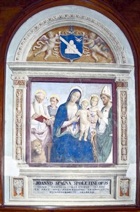
-
In 1799, Giovanni Turski, the commander of the Clitunno battalion of the army of the Roman Republic, arranged for the fresco to be detached and moved to Palazzo Comunale to protect it from his soldiers. The inscription that replaces the original predella attributes the work to lo Spagna and records its translation.
-
✴Three virtues
-
These detached frescoes of Charity, Justice (in a lunette) and Clemency were detached from the Rocca in 1827 and re-used in Palazzo Comunale, in this monument that commemorates the election of the Spoletan Annibale Sermattei della Genga as Pope Leo XII (1823-9).
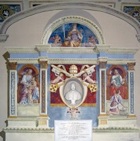
Madonna and Child with angels (ca. 1520)
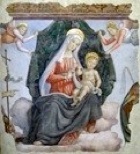
The confraternity commissioned an artist called Antonio di Brunotto to decorate the chapel in 1520. However, they retained the right to appoint another artist if he did not complete the work in the stipulated time. In fact, the work is usually attributed to lo Spagna and was documented with this attribution as early as 1581.
The fresco was covered by a new altarpiece during the re-modeling of the church and re-discovered by Giuseppe Sordini in 1907. The surviving fragment depicts the Madonna and Child on a cloud, in front of a cloth of honour held by angels. Fragments of the figures of St John the Baptist (holding a cross) and St Ambrose (holding the whip with which he defied heretics) can be seen to the sides. There is also a fragment of what was probably an image of God the Father above.
Crucifixion with saints (ca. 1520)
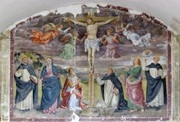
-
✴St Dominic;
-
✴the Virgin, who wears a form of the Dominican habit in order to claim her as the founder of the Order;
-
✴St Mary Magdalene;
-
✴St Peter Martyr;
-
✴St John the Evangelist; and
-
✴St Vincent Ferrer.
Angels above collect the blood from the wounds of Christ.
San Giacomo di Spoleto
Frescoes in the apse (1526)
Surviving documents record that some thirty inhabitants of San Giacomo contributed towards the payment for these frescoes by lo Spagna, which are dated by inscription.
-
✴St James is depicted at the centre, holding a book and the staff of a pilgrim.
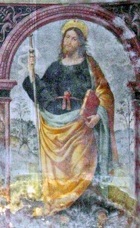
-
✴The scenes to each side depict two episodes in a legend of a couple that was making a pilgrimage to Compostela with their young son. He was unjustly accused of theft and condemned to hang, after which they continued sadly on their way.
-
•In the scene on the left, the couple return to the scene of the execution to find their son still alive, prevented from hanging by St .
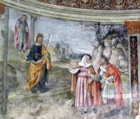
-
•In the scene on the right, they report the miracle to the incredulous judge, who looks up from his dinner to say that their son is dead as the roast chickens that he is about to eat. The chickens in question immediately come back to life.
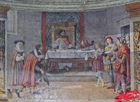
-
✴The fresco in the vault depicts the Coronation of the Virgin with saints and angels. This scene is inspired by the fresco (1469) on the same subject by Fillippo Lippi in the apse of the Duomo, Spoleto.
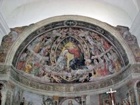
-
✴The frescoes on the triumphal arch depict:
-
•the figures of the Annunciation in tondi (above);
-
•St Lucy (on the left); and
-
•St Apollonia (on the right).
Madonna and Child with saints (1527)
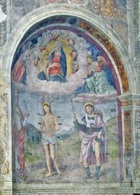
Gavelli, outside Spoleto
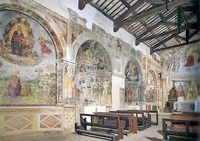
The church of San Michele Arcangelo here contains a number of frescoes by lo Spagna and his workshop.
Frescoes in the apse (1518)
These frescoes depict:
-
✴the Coronation of the Virgin (in the hemispherical vault);
-
✴SS Peter and Paul (on the left);
-
✴St Michael kills the devil (at the centre);
-
✴the apparition of St Michael on Monte Gargano (on the right).
Frescoes in the Cappella di San Sebastiano (1518)
This fresco depicts the Madonna and Child in glory with SS Sebastian, Catherine of Alexandria, Apollonia and John the Baptist.
Frescoes in the Cappella di San Girolamo (1523)
This badly damaged fresco depicts the Madonna and Child in glory with SS Jerome, Francis and Antony of Padua.
Assisi
Frescoes of early Franciscans (ca. 1514)
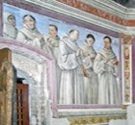
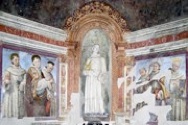
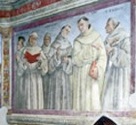
Giorgio Vasari attributed these frescoes in the Cappella del Transito, Santa Maria degli Angeli to lo Spagna. They depict:
-
✴Brothers Juniper, Philip, Morico and Bernard, four of St Francis early companions, with SS Otto and Adjutus, two of the five Franciscans protomartyrs (on the far left);
-
✴SS Antony of Padua and Bonaventure with the protomartyr St Berard (on the left);
-
✴the protomartyr St Peter with SS Louis of Toulouse and Bernardino of Siena (on the right); and
-
✴the protomartyr St Accursius with another five of St Francis early companions, Sylvester, Rufino, Masseo, Leo and Giles (on the far right).
Madonna and Child with saints (1516-7)
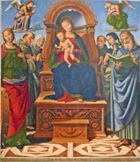
Maestà with saints (early 16th century)
This panel on the high altar of Santa Maria della Rocchicciola (at Rocca Sant’ Angelo, outside Assisi) is attributed to Giovanni di Pietro, lo Spagna. It depicts the Madonna and Child with SS Francis and Antony of Padua.
Perugia
Christ Carrying the Cross (ca. 1497)
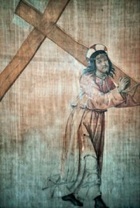
This panel is apparently documented as in existence in September 1497. It is usually attributed to the young lo Spagno, but its poor state of conservation make this uncertain. If he did indeed paint it before the documented date, it is his earliest known work.
St Francis receives the stigmata (ca. 1500)
This fresco, which was detached from the facade of the Convento di Monteripido in 1858 and moved to the Galleria Nazionale in 1863, is attributed to Lo Spagna. It depicts St Francis kneeling in a landscape as a seraph nailed to a Cross appears to him in the sky above. To the right, two of his companions obliviously continue reading.
Blessed Colomba da Rieti (ca. 1505)
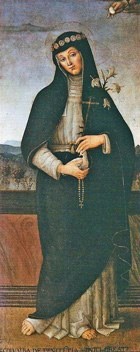
The panel depicts the Blessed Colomba standing on a terrace set in a landscape. She holds a dove, a rosary, a small wooden cross and a lily. The hand of Jesus appears in the top right hand corner, offering her the Host. The inscription along the bottom that identifies her seems to be a later addition.
Altarpiece of the Nativity (ca. 1510)
The lay sisters of the Compagnia di Nostra Donna commissioned this altarpiece from lo Spagna for their altar in Sant’ Antonio Abate. However, he completed only the central panel, and the sisters commissioned the lunette and predella panels from Mariano di Ser Austerio in 1510.
The Olivetans took the altarpiece to Montemorcino Nuovo in 1740 and it subsequently passed to the Accademia di Belle Arti.
-
✴The main panel, which depicts the Nativity, was given to the Joseph Marie de Gérando, a French administrator in Rome. His heirs subsequently sold it to the Musée du Louvre, Paris.
-
✴The lunette and predella panels are now in the deposit of the Galleria Nazionale.
Spello
Lo Spagna was documented in Spello on two separate occasions in 1502, and it possible that he worked with Pintoricchio on the frescoes (1501) of the Cappella Bella, Santa Maria Maggiore.
Madonna and Child (1501)

Terni
Backdrop to a Crucifix (16th century)
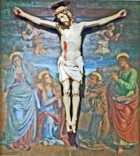
-
✴the wooden Crucifix (15th century), which is attributed to Giovanni Tedesco; and
-
✴the frescoed backdrop, which is attributed to lo Spagna. This depicts the Virgin and SS Mary Magdalene, Francis and John the Evangelist, with an image of San Francesco, Assisi behind the last two saints. The composition is based on the fresco (1502) by Perugino from the Franciscan Convento di Monte Ripido, Perugia, which is now in the Galleria Nazionale,Perugia.
Todi
Coronation of the Virgin (1507-11)
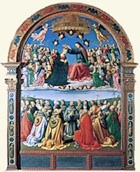
Madonna della Misercordia (ca. 1510)
This detached fresco, which is attributed to Lo Spagna, belonged to the Poor Clares of Montecristo. Lo Spagna probably painted it during his stay at nearby Montesanto in 1507-11. It was subsequently detached and finally moved to its current location on the left wall of San Carlo (formerly Sant' Ilario) in 1728. In 1762, the Confraternita dei Muratori (Bricklayers’ Guild) built an altar for it in San Carlo. The fresco has been heavily repainted, and is in a poor state of preservation.
SS Peter and Paul (1516)
These small paintings, which belong to a documented commission of work from lo Spagna, are on the pilasters that flank the presbytery of the Duomo. They were originally used as part of the decoration of an organ that was installed in 1515 and later removed, probably to make way for one of the chapels that Bishop Angelo Cesi built in 1599. These two panels were probably conserved because of the original dedication of the Duomo to SS Peter and Paul.
Trinity (1525)
This damaged detached fresco fragment is in the 5th bay of the navatina (the 2nd aisle on the right) of the Duomo. It is all that survives from three separate commissions that lo Spagna received for the frescoes of three niches in the right wall:
-
✴a certain Agamennone paid lo Spagna for the first of these in 1513; and
-
✴donna Clarice paid for the other two:
-
•in 1515; and
-
•in 1525.
These frescoes were later plastered over. The surviving fragment, which came from the last of these commissions, was originally part of a larger composition, but this was inadvertently damaged in 1850 when the side door was re-opened. The frescoes were rediscovered thereafter, and the fragment of the Trinity was detached. It adorned an altar in the left aisle until 1958, when it was moved to its current location.
St Bernardino da Feltre (16th century)
This panel by lo Spagna came from the Santa Maria di Montesanto. The saint holds three model mountains with a miniature Pietà above, signifying the Monti di Pietà that he had established in Todi. This panel is now in the Pinacoteca.
St Bernardino da Feltre (16th century)
This fresco on the right wall of Santa Maria di Montesanto was re-discovered in 1956 and restored in 1989. The saint holds three model mountains, one of which has a miniature Pietà at its summit, signifying the Monti di Pietà that he had established in Todi.
Madonna della Luce (16th century)
This altarpiece of the Madonna and Child, which is attributed to lo Spagna, has been recovered from under the plaster of the right wall of San Giorgio. The Madonna sits on a Renaissance throne set against a landscape, and holds a pear.
Trevi
Assumption of the Virgin (1512)
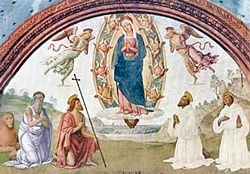
This fine fresco in the Cappella di San Girolamo, outside in San Martino is attributed to lo Spagna and dated by inscription. Four saints witness the Assumption:
-
✴SS Jerome (with his lion) and John the Baptist on the left; and
-
✴SS Francis and Antony of Padua (both of whom, unusually, wear white habits) on the right.
The scene is set in a landscape outside Trevi, with Foligno, as seen from San Martino, in the distance.
Frescoes (1518-20)
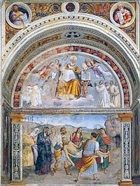
-
✴The main scene of the Deposition is based on Raphael’s Pala Oddi (ca. 1503), which was originally in San Francesco al Prato, Perugia.
-
✴Figures of SS Ubaldus and Joseph (with his flowering staff) are on the side walls.
-
✴The lunette contains a figure of St Augustine with kneeling figures in white habits, presumably those of the Lateran Canons.
SS Cecilia and Catherine (ca. 1520)
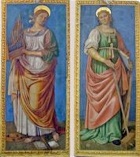
Coronation of the Virgin (1522)
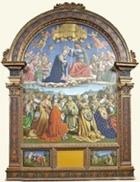
The main panel of the Trevi altarpiece is clearly based on that of lo Spagna's altarpiece at Santa Maria di Montesanto, Todi (see above), albeit that the lower part of it has been inverted. This, in turn, had been based on the altarpiece (1486) that Domenico Ghirlandaio had painted for the Observant Franciscans of San Girolamo, Narni.
-
✴In the upper part, Christ crowns the Virgin to the accompaniment of musical angels.
-
✴The lower part is set in a landscape of the Valle Umbra, with San Francesco, Assisi clearly visible to the right. Here, a group of kneeling saints meditate on the coronation:
-
•St Francis, kneeling at the centre;
-
•SS Martin (the titular of the church) and Bernardino of Siena immediately behind him (to the left and right respectively);
-
•SS Mary Magdalene, Bonaventure, John the Baptist and Jerome on the left;
-
• SS Augustine, Antony of Padua, Louis of Toulouse and Catherine of Alexandria on the right; and
-
•a number of Franciscan saints behind.
The predella panels in the Pinacoteca depict:
-
✴St Martin and the beggar; and
-
✴the stigmatisation of St Francis.



